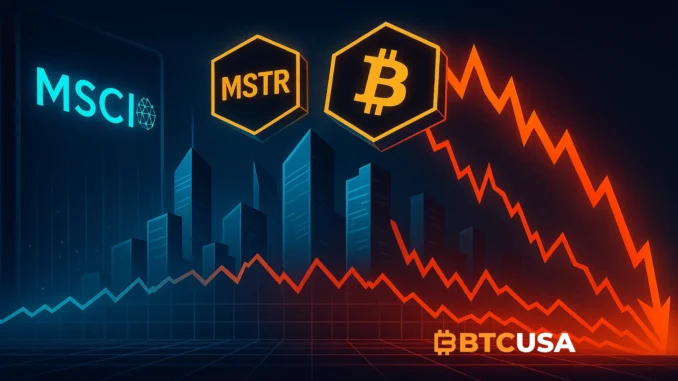
What Really Caused the October 10 Market Crash
The sharp market drop on October 10 appears to have a deeper structural explanation than simple fear or volatility. According to emerging analysis, the real catalyst was an announcement by MSCI — the world’s second-largest index provider — regarding the classification of crypto-holding companies.
These companies, referred to as Digital Asset Treasuries (DATs), include firms such as MSTR, BMNR and others that hold large reserves of Bitcoin on their balance sheets.
They were among the two main pillars driving buying pressure throughout the current market cycle.
The DAT Growth Model and Index Inclusion
The strategy of these companies is straightforward:
Grow large enough to be included in major global indices. Once included, passive funds tracking those indices are forced to buy their shares. This drives market capitalization higher, leading to further index inclusion and more passive inflows.
This self-reinforcing feedback loop has generated substantial upward pressure — not just on the companies themselves, but on Bitcoin as well.
Why MSCI’s Decision Is So Important
On October 10, MSCI announced it is considering whether companies that primarily hold crypto should be classified as companies or as funds.
If they are reclassified as funds, they will automatically be excluded from passive indices. This is to avoid a circular structure where a fund buys assets, grows, enters an index, attracts more fund flows, and then buys even more assets.
The decision is expected on January 15, 2026.
If the outcome is negative, firms like MSTR could be removed from major indices overnight.
Forced Selling by Index Funds Could Follow
A negative classification would likely trigger automatic selling by:
• Pension funds
• Index-tracking funds
• Institutional strategies
• ETFs and passive investment managers
This would represent a structural sell-off, unrelated to sentiment. Purely mechanical. And massive in scale.
Markets tend to price in such risks early — which explains the violent reaction immediately after the MSCI announcement.
Why the Market Failed to Recover
The reason the market failed to stage a meaningful rebound after October 10 is simple: smart money recognized the risk instantly.
When the foundation of the buying mechanism is threatened, capital steps aside. This is not panic — this is risk management.
Without the certainty of future index-driven inflows, a major engine of this cycle is placed in doubt.
What Happens Next
Two scenarios now define the market’s trajectory:
If MSCI rules against inclusion — a deep corrective phase is likely, as funds front-run the eventual exclusion process.
If MSCI rules in favor — the entire cycle receives a renewed green light, and the structural demand returns.
Until that clarity arrives, pressure is expected to persist through the end of December.
This Was Not a Random Crash
The October 10 drop was not chaos or coincidence. It was capital reacting to a structural threat detected early.
What appeared as panic to retail traders may have actually been one of the most rational moves of the entire cycle.


